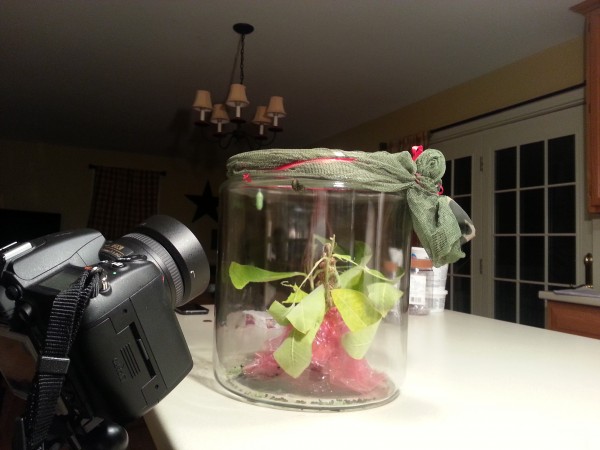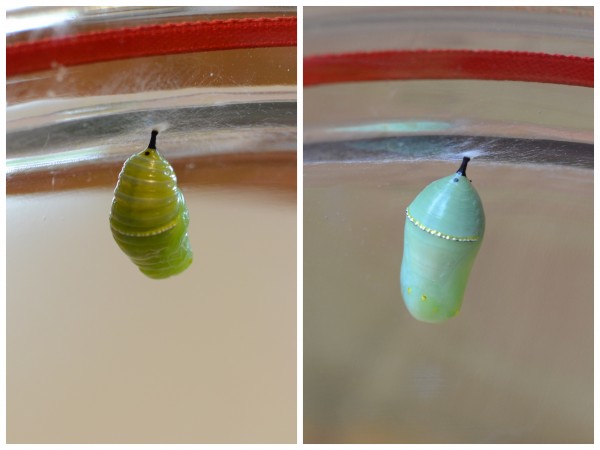Nature Study ~ Mesmerized by Monarch Metamorphosis
I really wanted to raise caterpillars into butterflies for the kids to watch. I really wanted them to be monarch caterpillars. We’d done it years ago and the amazing process is still etched in my mind but even my 10 year old’s memory of it is fuzzy. The caterpillar is striking and not hairy (my son got hives from a hairy caterpillar last year so both my kids now refuse to touch any caterpillars with hair), the chrysalis is like a jewel, and the butterfly is beautiful. The problem: I couldn’t justify the $26 in shipping charges to order monarch caterpillars.
I was determined and, after looking at countless images online felt I could recognize milkweed–the only food monarch caterpillars will eat. This was one of those times when my husband just shook his head, because he knows I get an idea in my head and can’t let it go. He chuckled as I looked into roadside wildflowers on our walks and in the car. I took my family on some crazy back-road drives until I found a country road with tons of milkweed…and I went searching. Here’s me up to my waist in a field of milkweed, searching for teeny-tiny caterpillars. I would have been happy with eggs, too, but since they’re the size of the head of a pin I decided that just might be impossible. My family cheered me on from inside the bug-free car as I battled the mosquitos.

Finally–success! Two monarch caterpillars came home with us. The smallest one (dubbed “Little Guy”) was so tiny he was still whitish with a dark head. “Big Guy” was already getting the striped pattern characteristic of monarch caterpillars. We set them up right in the middle of our kitchen island. Yup, we’re homeschoolers.

It was amazing how fast they grew! We had several opportunities to watch them molt. We were in awe of how much they could consume in a day, and how much frass (new vocabulary word for my son to avoid the common word for it) they could make.

I found that keeping the stems in a small jar of water kept the leaves fresh enough to last a few days, since I had to drive to get leaves for them. One morning I woke up to this and had to go get more leaves before everyone was even out of bed!

Finally the moment we’d been waiting for: Big Guy moved to the top of the container, attached himself and hung upside down in a “J” shape. We watched with excitement but ended up missing the moment of transformation into a chrysalis!

When it was Little Guy’s turn a couple days later my kids were determined not to miss it. I was afraid it would happen in the night and they didn’t want to go to bed. Mr. Tech Support (my husband) saved the day. He reminded me that the fancy camera he bought me can do time lapse photography, so we set it up to take photos all night long just in case. (Okay, maybe we’re crazy…but the kids were excited and I wanted them to sleep!)

The caterpillar was still hanging in a J-shape the next morning so we set ourselves up to provide constant surveillance. I decided to keep the camera set up taking time lapse because it was really neat now that I’d figured out how to do it. (In fact, I may be taking time lapse photos of everything from science experiments to the cat napping. It’s fun!)

We made sure one of us had our eyes on it the whole time. Finally my daughter yelled and we witnessed the amazing transformation of this black, yellow, and white caterpillar with legs and antennae to a pale green chrysalis with a completely different shape. If you are interested here is my first amateur attempt at time-lapse photography:
We were amazed at the transformation, and how much the early pupae moved about to shed the old skin and attain its final form. Initially you could see the ridges from the caterpillar’s body and some striping, but the color changed and the chrysalis became more opaque. By the end it was a smooth, lovely shade of green. My favorite part are the markings that look like drops of gold paint. Truly amazing.

As we’ve been mesmerized by this process we’ve learned a lot about monarchs and butterflies in general using these resources:
- Real Science Odyssey Life Level One: Our new science curriculum had a unit on insects with specific labs about caterpillars and butterflies, so we did the corresponding lessons and journal pages. It meant working out of order but we had to work with nature on this one!
- Go-Along books:- It’s a Butterfly’s Lifeby Irene Kelly: This book has great information on all kinds of butterflies with beautiful drawings, and also fun facts about defense mechanisms and frass (both of particular interest to a six-year-old boy).- The Magic School Bus and the Butterfly Bunch: A good book for covering the life cycle of butterflies.- National Geographic Kids Great Migrations: Butterflies by Laura Marsh: This book has terrific photographs to illustrate the migration of monarch butterflies, a truly amazing feat.
- Magic School Bus episode “The Butterfly and the Bog Beast” (on our Bugs, Bugs, Bugs! DVD): The Magic School Bus show is a favorite around here. This episode gives great information on how butterflies are tough little creatures with many defenses.
- We used just about everything Barb put out for the Outdoor Hour Challenge on monarch butterflies. I highly recommend the You Tube vidoes on monarch migration–it really is an amazing journey! We enjoyed all of the links under “suggested resources to view or print” from learner.org. They have easy-to-understand information on monarchs and their annual cycle, and the link about wings was information we hadn’t read elsewhere. The corresponding information from the Handbook of Nature Study led to some microscope fun: we pulled out our pocket microscopes after I found these unfortunate guys in our garage.
 We’d read how the wings are covered with scales arranged in perfect rows, so it was wonderful to see for ourselves. It was also neat to read about the actions of the antennae when the caterpillar is frightened, something we’d observed when we spoke too loudly near the top of their glass container.
We’d read how the wings are covered with scales arranged in perfect rows, so it was wonderful to see for ourselves. It was also neat to read about the actions of the antennae when the caterpillar is frightened, something we’d observed when we spoke too loudly near the top of their glass container.
So now we anxiously await our butterflies. We think of Big Guy and Little Guy just under that green covering, preparing to become creatures that can fly. The transformation takes 10-14 days. This has been an amazing study, and for our family reinforced the wonders of God’s creation. I’ll be sure to update with photos when our butterflies emerge!
***Updated: Here is the post on our Monarch butterflies emerging and being released into nature!***
I’m submitting this to Barb’s Outdoor Hour Challenge Blog Carnival. Be sure to visit her site for nature study ideas, and watch for her blog carnival to see all the amazing summer nature study happening.

 Hi, I'm Heidi and I homeschool my two sweet kids. I want them to know that learning is an exciting lifelong adventure! We love great books, unit studies, notebooking, lapbooking, and hands-on learning.
Hi, I'm Heidi and I homeschool my two sweet kids. I want them to know that learning is an exciting lifelong adventure! We love great books, unit studies, notebooking, lapbooking, and hands-on learning.



